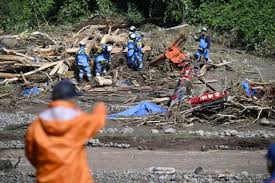
Japan’s Noto Peninsula, already reeling from a series of earthquakes, was hit by devastating floods, leading to the tragic loss of at least six lives. Heavy rains have compounded the situation, causing landslides, power outages, and further destruction across the region. Authorities are racing against time to rescue stranded residents and prevent more casualties.
Overview of the Disaster
In a tragic turn of events, Japan’s Noto Peninsula, located in Ishikawa Prefecture, has been struck by deadly floods after enduring a string of earthquakes in recent months. Torrential downpours have overwhelmed the area, leading to flash floods, landslides, and submerged homes. The floods have claimed the lives of at least six people, and many more remain missing. With infrastructure severely impacted, the region is facing one of its worst natural disasters in recent history.
The Noto Peninsula: A Region Under Stress
The Noto Peninsula, located on Japan’s western coast, has been grappling with seismic activity for several months. A series of earthquakes had already strained local resources and infrastructure. Many buildings, already weakened by the quakes, were ill-prepared for the relentless rains that have now battered the region. The combination of quakes and floods has made the situation particularly dire, with vulnerable structures collapsing under the weight of water and landslides.
Rescue Efforts and Challenges
Emergency response teams have been dispatched to the area, but rescue operations are being hampered by the scale of the destruction. Flooded roads and bridges have cut off entire communities, leaving them stranded without access to essential supplies or medical care. Helicopters and boats have been mobilized to reach those trapped by floodwaters. Despite these efforts, the continuous rainfall and unstable terrain have made it difficult to safely carry out rescues.
Impact on Local Communities
The local communities on the Noto Peninsula have been severely affected by this dual disaster. With homes and farmland submerged, many residents are now displaced, forced to seek shelter in evacuation centers. Electricity and water supply have been disrupted in several areas, making daily survival even more challenging. Businesses and schools have been forced to close, and the region’s economy, already strained by the earlier earthquakes, now faces further challenges.
Government Response and Relief Efforts
The Japanese government has declared a state of emergency in the Noto Peninsula and surrounding areas. Prime Minister Fumio Kishida has pledged full support to the victims and mobilized the Self-Defense Forces to aid in rescue and recovery efforts. Local authorities are working with national agencies to provide relief to affected residents, including temporary shelters, food, and medical aid. The government is also coordinating with meteorological agencies to monitor the weather conditions and issue warnings for potential further flooding.
Environmental and Infrastructural Damage
The floods have caused extensive environmental damage, with rivers overflowing, and landslides sweeping away vegetation and soil. The already fragile infrastructure has been further compromised, with roads, bridges, and railway lines washed away or severely damaged. Engineers and emergency response teams are now focused on restoring essential services, but it could take weeks or even months for normalcy to return.
Ongoing Threats and Future Outlook
As weather patterns remain unpredictable, the risk of further flooding remains high. Experts warn that the region could see continued heavy rainfall, exacerbating the already critical situation. Additionally, the weakened ground structure from earthquakes poses a heightened risk of more landslides. The government and disaster management teams are urging residents in high-risk areas to remain vigilant and follow evacuation orders promptly.
The floods that have ravaged Japan’s Noto Peninsula represent a grim reminder of the vulnerability of regions already weakened by natural disasters. With the death toll expected to rise, and many still missing, the full extent of the disaster remains uncertain. As rescue and recovery operations continue, Japan faces the dual challenge of rebuilding a region battered by both earthquakes and floods. The resilience of the local population, coupled with strong governmental support, will be key to overcoming the immediate and long-term effects of this calamity.
Subscribe to Follow Global Trends for daily global news.
Find Out How To Make Money As A Full Time Writer/Blogger Guide.
To Advertise, Advertise Your Affiliate Links on FollowGlobalTrends.com for Just $1 Per Link Per Month!
Related Articles
Flash Floods Leave Dozens Missing in Yemen, Further Raise Cholera Risk
Deadly Floods Leave Millions Stranded in Bangladesh: A Catastrophe Unfolds
Devastating Flash Floods Strike Afghanistan
Brazil floods raise specter of climate migration
Tragedy Strikes Amidst Texas Floods
Written by: Enyoghasi Ngozi pricillia

